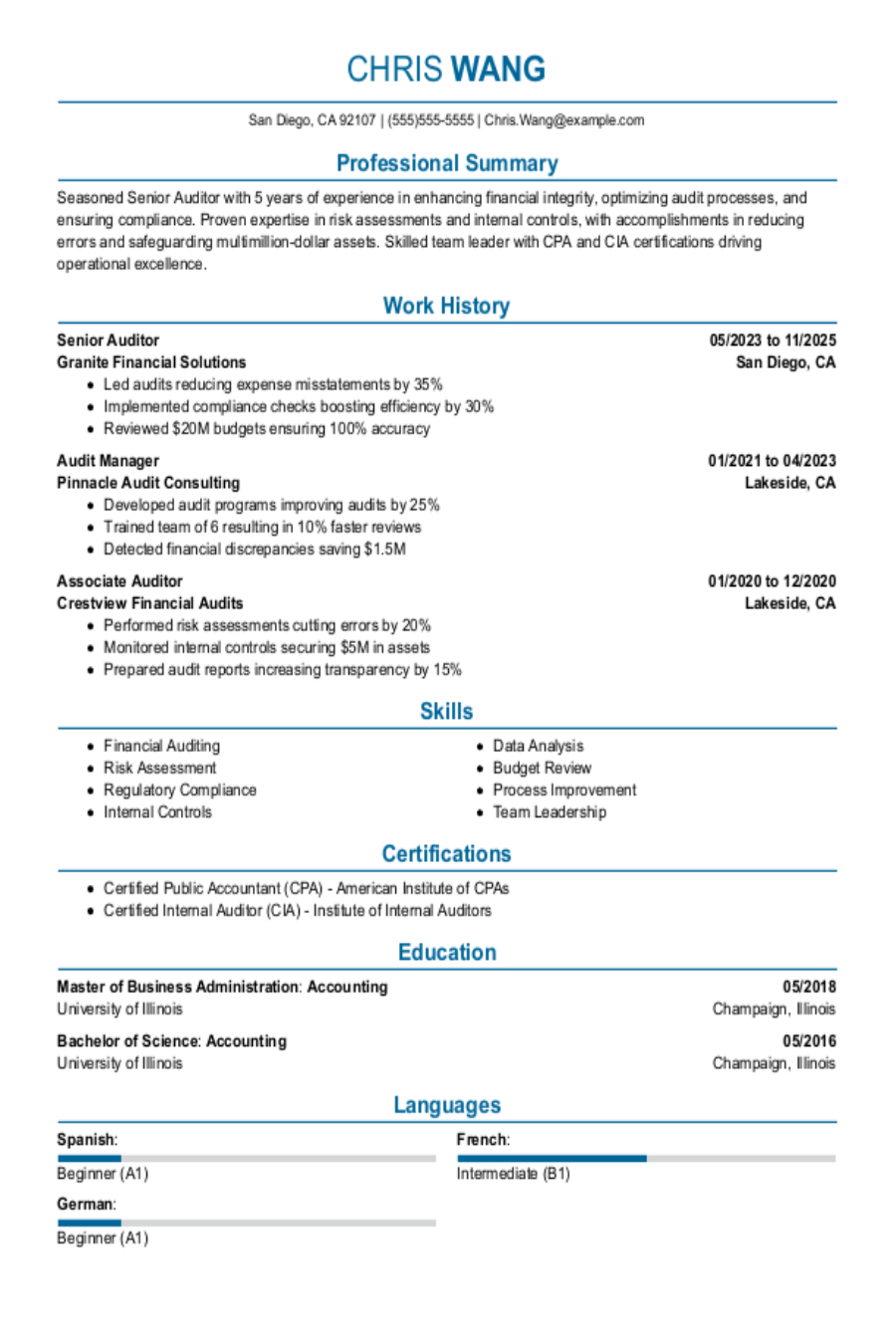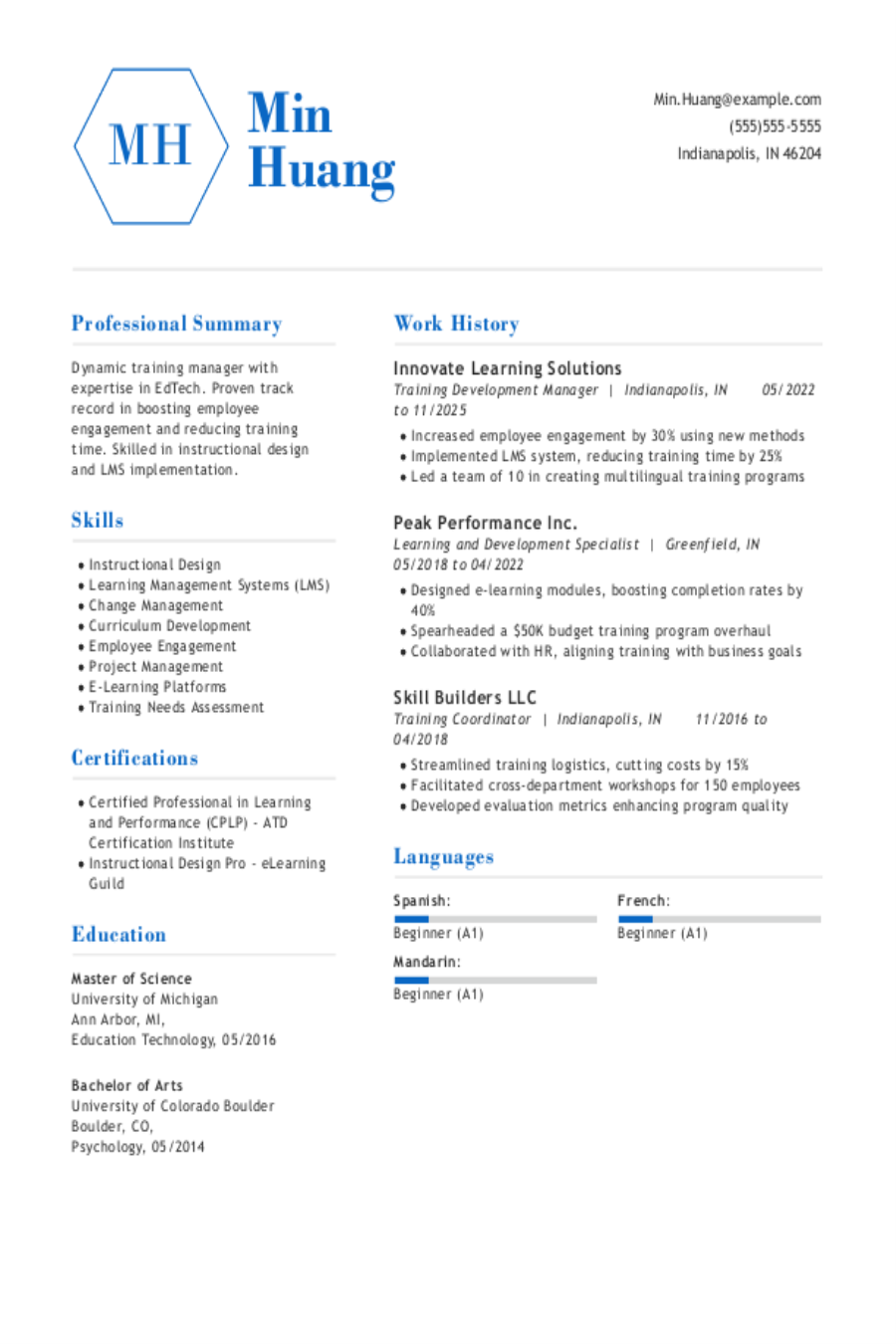Popular Executive Resume Examples
Mid-career executive resume
A mid-career executive resume should emphasize leadership achievements, strategic skills, and continuous professional development to demonstrate a strong capacity for driving organizational success and innovation.
Begins with a powerful summary: This resume's professional summary highlights essential qualifications, showcasing the executive's leadership experience and successful track record. This clarity aids recruiters and ATS in recognizing relevant skills efficiently.
Encourages quick scanning: A streamlined layout and clear organization highlight the job seeker's key achievements, making it effortless for hiring managers to recognize their suitability for executive roles.
Experienced executive resume
An experienced executive resume should prioritize highlighting leadership achievements and strategic impact, presenting a clear picture of professional growth and contributions to organizational success.
Highlights experience: This resume's opening summary immediately showcases the applicant's impressive 14 years of leadership experience, emphasizing strategic planning and revenue growth. This sets a confident and professional tone, aligning perfectly with the expectations for an executive role.
Optimized for ATS: This resume uses a sophisticated template that merges a professional header with an ATS-friendly resume layout, facilitating efficient parsing by automated systems while appealing to human recruiters.
More resume examples
Additional Guides
- Art
- Artist
- Banking
- Biotech
- Budtender
- Business
- Business Operations
- Cashier
- Chef
- Chemistry
- College
- Communications
- Computer
- Computer Science
- Construction
- Consultant
- Cook
- Customer Service
- Customer Success Manager
- Cyber Security
- Dentistry
- Driving
- ECommerce
- Engineering
- Entry Level
- Esthetician
- Federal
- Firefighter
- Food Service
- Government
- Graduate
- Graphic Designer
- Handyman
- Healthcare Support
- High School Student
- Hospitality
- Human Resources
- Industrial Engineering
- Insurance
- Interior Design
- Internship
- IT
- Law
- Manager
- Marketing
- Medical
- Military
- Music
- Nursing
- Performing Arts
- Pharmacy Technician
- Photographer
- Physical Therapy
- Pilot
- Product Manager
- Product Owner
- Production Assistant
- Program Manager
- Project Manager
- Psychology
- Radiologic Technologist
- Real Estate
- Restaurant Manager
- Retail
- Sales
- Sales Associate
- Scholarship
- Server
- Skilled Trades
- Social Services
- Software Engineer
- Stay At Home Mom
- Student
- Supervisor
- Teacher
- Teen
- Training Development
- Ux Designer
- Virtual Assistant
- Waitress
Executive Resume Template
Looking for a solid foundation? Check out this executive resume template that you can easily personalize with your own experiences and qualifications.
Emma Nguyen
Minneapolis, MN 55406
(555)555-5555
Emma.Nguyen@example.com
Professional Summary
Dynamic executive with over 8 years leading high-impact teams. Proven success in boosting revenue, improving operational efficiency, and driving business growth through strategic initiatives.
Work History
Executive
Innovative Solutions Inc. - Minneapolis, MN
January 2022 - November 2025
- Led a team to increase sales by 35%
- Implemented cost-saving measures, reducing expenses by 20%
- Developed strategic partnerships, expanding reach by 15%
Senior Manager
Strategic Growth Partners - Cedar Valley, MN
January 2018 - December 2021
- Enhanced productivity by 25% through workflow optimization
- Negotiated contracts, achieving a 40% revenue increase
- Directed marketing efforts, boosting engagement by 50%
Operations Director
Efficiency Innovations Ltd. - Cedar Valley, MN
January 2017 - December 2017
- Streamlined operations, reducing lead time by 15%
- Supervised project delivery, improving client satisfaction by 40%
- Introduced automated systems, saving $100k annually
Skills
- Leadership
- Strategic Planning
- Project Management
- Negotiation
- Financial Analysis
- Team Building
- Operational Efficiency
- Business Development
Certifications
- Certified Business Executive - International Business Association
- Project Management Professional (PMP) - Project Management Institute
Education
Master of Business Administration Business Management
Harvard Business School Cambridge, Massachusetts
May 2017
Bachelor of Arts Economics
University of California, Berkeley Berkeley, California
May 2015
Languages
- Spanish - Beginner (A1)
- French - Beginner (A1)
- Mandarin - Beginner (A1)
Must-Have Skills on a Executive Resume
A strong skills section is important for building a standout resume. It showcases your qualifications and helps you grab the attention of hiring managers.
The following data highlights the most sought-after hard and soft skills for executive roles, based on insights from Resume Now’s extensive resume database.
When you’re ready to improve your resume with relevant skills, check out our AI Resume Skills Generator. This tool recommends both hard and soft skills tailored to your job title, ensuring your skill set stands out.
Writing Your Executive Resume
Having explored these compelling resume examples, you are now prepared to dive into the process of how to write a resume. We'll provide a step-by-step guide, detailing each section to ensure your success.
List your most relevant skills
A compelling skills section on your executive resume should highlight both technical abilities and essential soft skills like leadership, strategic thinking, and decision-making. This section allows you to align your expertise with the specific requirements of the role, making it easier for recruiters to see your fit within their organization.
To maximize the effectiveness of your skills section, ensure you incorporate keywords from the job listing. By doing this, you not only cater to human readers but also optimize your resume for applicant tracking systems (ATS).
Example of skills on an executive resume
- Proficient in strategic planning and execution to drive business growth
- Adept at building and maintaining strong client relationships
- Strong leader with expertise in cross-functional team collaboration
- Analytical thinker with excellent problem-solving skills
Highlighting your soft skills on your resume can set you apart from other applicants. Employers deeply value interpersonal abilities, as they are often challenging to develop and essential for fostering a positive workplace culture.
Highlight your work history
Your work experience section should emphasize your achievements and illustrate how you've effectively used your skills in past roles. Focus on specific accomplishments that highlight your impact, using action-oriented language and relevant keywords to catch the attention of hiring managers.
Each job entry must include essential details like your title, employer, and dates of employment. Providing this information helps establish your credibility and allows employers to quickly assess your professional background. Remember to include any significant projects or initiatives you led that resulted in measurable success.
Example of an executive work experience entry
- Executive
Global Enterprises - New York, NY
January 2019 - Present - Lead strategic initiatives that drove a 30% increase in annual revenue through innovative marketing campaigns and market expansion strategies
- Foster relationships with key stakeholders, improving partnerships that resulted in a 25% improvement in client retention rates
- Oversee cross-functional teams to ensure alignment on project goals, delivering results ahead of schedule while maintaining budgetary constraints
- Mentor emerging leaders within the organization, contributing to a 15% rise in employee satisfaction scores and promoting a culture of continuous improvement
- Implement data-driven decision-making processes that improved operational efficiency by 20%, streamlining workflows across departments
Aim for clarity in your resume bullet points. Focus on specific achievements that highlight your impact, using concise phrases that communicate results without unnecessary detail.
Include your education
The education section of your executive resume should clearly list your diplomas and degrees in reverse-chronological order, starting with the most recent. You can exclude your high school diploma if you have a bachelor's degree or higher.
If you are currently pursuing further education or have incomplete studies, indicate the highest level completed along with an expected graduation date.
Common certifications for an executive resume
- Certified Management Executive (CME) – Institute of Certified Professional Managers (ICPM)
- Project Management Professional (PMP) – Project Management Institute (PMI)
- Chartered Manager (CMgr) – Chartered Management Institute (CMI)
- Certified Executive Coach (CEC) – Center for Executive Coaching
Sum up your resume with an introduction
Creating a strong profile section in your resume is essential for making a memorable first impression. This segment serves as your professional introduction, giving potential employers insight into who you are and what you bring to the table.
If you have substantial experience, a professional summary is the most effective way to showcase your accomplishments right at the top of your resume. This format allows you to highlight key achievements and skills that align with the position you're applying for. If you’re just starting out, write a resume objective that highlights your commitment to building your career.
Professional summary example
Dynamic executive with over 10 years of experience in driving strategic initiatives and leading high-performing teams. Demonstrated success in improving operational efficiency, fostering innovation, and achieving substantial revenue growth. Expert in stakeholder engagement, data-driven decision-making, and transformational leadership.
Resume objective example
Ambitious executive aspiring to use strong leadership, strategic planning, and communication skills to drive business growth in a collaborative environment. Eager to contribute innovative solutions and foster team success while improving operational efficiency.
In your resume profile, begin with your job title, whether you choose a professional summary or an objective statement. This approach helps employers quickly understand your professional identity and what you bring to the table.
Add unique sections to set you apart
Optional resume sections are a great way to highlight your unique qualifications for executive positions. They provide insight into your professional journey beyond the standard work experience and education.
These sections allow you to showcase hobbies or volunteer activities that align with your values and demonstrate relevant skills. For example, if you've volunteered in leadership roles or participated in community initiatives, it reflects your commitment to service and teamwork.
Three sections perfect for a executive resume
- Languages: As an executive, effective communication is important for building relationships. Highlighting your language skills on your resume can improve collaboration and foster connections with diverse teams and clients.
- Volunteer Work: Incorporating volunteer work on a resume improves your professional profile. It not only showcases your skills but also highlights your dedication to community service, making you a more appealing applicant to potential employers.
- Quantifiable Metrics: As an executive, measurable results are important to showcase your leadership impact. Feature these achievements by folding them into your work experience or outlining them in a unique accomplishments section.
5 Resume Formatting Tips
- Choose a format that matches your career stage.
Choosing the appropriate resume format is important for effectively showcasing your experience. For executives, a chronological format can highlight career progression. If you have diverse skills, a functional format might better emphasize your strengths. To present both your work history and key accomplishments clearly, consider using a combination format.
- Pick a smart resume template.
Using a professional resume template improves readability and ensures your information stands out. A well-structured template allows hiring managers to quickly grasp your qualifications. If you opt for a custom format, keep it clean and choose fonts that are easy to read while being compatible with ATS systems.
- Select an appropriate font.
Choose a clean and professional font to improve resume readability. Fonts like Helvetica, Georgia, or Garamond are effective for both ATS scanning and human review.
- Use consistent formatting.
Ensure your resume features uniform margins and is neatly left-aligned to improve readability and convey a polished, professional image.
- Keep your resume to one or two pages.
When outlining your resume, remember that resumes should be one page long. If you have extensive experience, a two-page format can work, but ensure every detail is relevant and clearly presented to highlight your strengths effectively.
Tools for Your Job Search
Are you ready to advance your executive career and make a powerful impression? Before sending out your application, use our ATS Resume Checker to ensure your resume is optimized for the automated systems many top companies rely on for initial job seeker screening.
Seeking further enhancement of your professional presentation? Our AI Resume Builder provides intelligent content suggestions specifically tailored to highlight your leadership experiences and strategic achievements, along with professionally designed templates that capture the attention of hiring executives.
Frequently Asked Questions
Last Updated: November 21, 2025
Absolutely. A cover letter is important as it provides context to your resume, allowing you to communicate directly with potential employers. It’s your opportunity to express what draws you to the role and how your unique experience positions you as the ideal job seeker. Don’t miss out—write a cover letter that improves your application.
For an effortless solution, consider our AI Cover Letter Generator, designed to help you create a customized, strong cover letter in just minutes. You can choose from various cover letter template options that perfectly match your resume, ensuring a polished and professional presentation of your qualifications.
A resume is typically a concise document, spanning one to two pages that highlights your skills, experiences, and qualifications relevant to a specific job. In contrast, a CV (curriculum vitae) can extend several pages and includes comprehensive details about your academic background, research contributions, publications, and extensive professional experience.
You should use a CV when applying for positions in academia or specialized fields like law or medicine. If you're required to submit a CV for your application, our online CV Maker can assist you in creating an impressive document quickly. Choose from our diverse range of CV templates designed for various industries and career levels to make your application stand out.
Selecting the right resume format hinges on your career stage and unique abilities. Inexperienced job seekers should consider a functional format, which highlights relevant skills over work history. For seasoned professionals, a chronological format is ideal as it showcases extensive experience in a clear timeline. Mid-level job seekers may find success with a combination format, integrating both skills and experience to present a well-rounded profile that appeals to potential employers.
An engaging LinkedIn profile is important for executives seeking new opportunities. It allows you to connect with industry leaders and effectively highlight your expertise and accomplishments.
Was this information helpful? Let us know!
Hailey is a career advice writer dedicated to helping job seekers excel in their careers.
More resources

How to Make a Canadian Resume (Format, Template + Examples)
Creating a Canadian resume is key to getting a job in Canada. ...

How to Write a Resume for an Internal Position (Guide + Examples)
Ready for a new role within the same company? We ll help you...

The Great Workplace Reckoning: How 2025 Burned Out Workers & What’s Next for 2026
The workforce spent much of 2025 in survival mode navigating ...

Chemistry Resume: Examples, Templates & Tips
Make a chemistry resume that gets interviews. Use our writing ...



